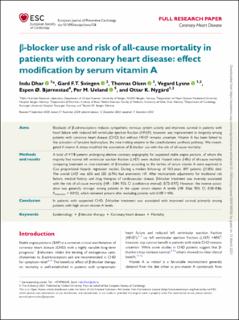| dc.contributor.author | Dhar, Indu | |
| dc.contributor.author | Svingen, Gard Frodahl Tveitevåg | |
| dc.contributor.author | Olsen, Thomas | |
| dc.contributor.author | Lysne, Vegard | |
| dc.contributor.author | Bjørnestad, Espen Øglænd | |
| dc.contributor.author | Ueland, Per Magne | |
| dc.contributor.author | Nygård, Ottar Kjell | |
| dc.date.accessioned | 2021-08-05T07:18:01Z | |
| dc.date.available | 2021-08-05T07:18:01Z | |
| dc.date.created | 2021-03-13T12:17:02Z | |
| dc.date.issued | 2021 | |
| dc.identifier.issn | 2047-4873 | |
| dc.identifier.uri | https://hdl.handle.net/11250/2766332 | |
| dc.description.abstract | Aims
Blockade of β-adrenoceptors reduces sympathetic nervous system activity and improves survival in patients with heart failure with reduced left ventricular ejection fraction (HFrEF); however, any improvement in longevity among patients with coronary heart disease (CHD) but without HFrEF remains uncertain. Vitamin A has been linked to the activation of tyrosine hydroxylase, the rate‐limiting enzyme in the catecholamine synthesis pathway. We investigated if vitamin A status modified the association of β-blocker use with the risk of all-cause mortality.
Methods and results
A total of 4118 patients undergoing elective coronary angiography for suspected stable angina pectoris, of whom the majority had normal left ventricular ejection fraction (LVEF) were studied. Hazard ratios (HRs) of all-cause mortality comparing treatment vs. non-treatment of β-blockers according to the tertiles of serum vitamin A were explored in Cox proportional hazards regression models. During a median follow-up of 10.3 years, 897 patients (21.8%) died. The overall LVEF was 65% and 283 (6.9%) had anamnestic HF. After multivariable adjustments for traditional risk factors, medical history, and drug therapies of cardiovascular disease, β-blocker treatment was inversely associated with the risk of all-cause mortality [HR : 0.84; 95% CI (confidence interval), 0.72–0.97]. However, the inverse association was generally stronger among patients in the upper serum vitamin A tertile (HR :0.66; 95% CI, 0.50–0.86; Pinteraction = 0.012), which remained present after excluding patients with LVEF < 40%.
Conclusion
In patients with suspected CHD, β-blocker treatment was associated with improved survival primarily among patients with high serum vitamin A levels. | en_US |
| dc.language.iso | eng | en_US |
| dc.publisher | Oxford University Press | en_US |
| dc.rights | Navngivelse-Ikkekommersiell 4.0 Internasjonal | * |
| dc.rights.uri | http://creativecommons.org/licenses/by-nc/4.0/deed.no | * |
| dc.title | β-blocker use and risk of all-cause mortality in patients with coronary heart disease: effect modification by serum vitamin A | en_US |
| dc.type | Journal article | en_US |
| dc.type | Peer reviewed | en_US |
| dc.description.version | publishedVersion | en_US |
| dc.rights.holder | Copyright 2021 The Authors | en_US |
| dc.source.articlenumber | zwaa158 | en_US |
| cristin.ispublished | true | |
| cristin.fulltext | original | |
| cristin.qualitycode | 2 | |
| dc.identifier.doi | 10.1093/eurjpc/zwaa158 | |
| dc.identifier.cristin | 1897829 | |
| dc.source.journal | European Journal of Preventive Cardiology (EJPC) | en_US |
| dc.identifier.citation | European Journal of Preventive Cardiology (EJPC). 2021 | en_US |

